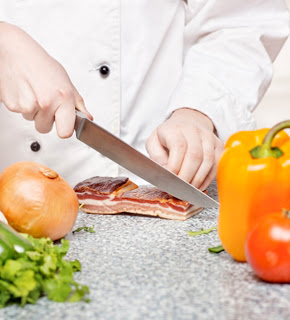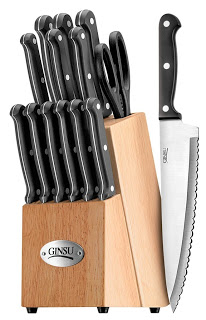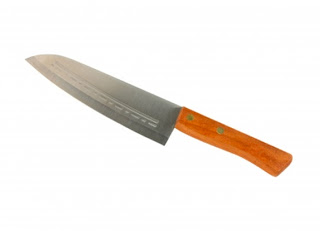When my daughter was preparing to get married, one of the items on her to-do list was set up a gift registry. We did it together since I was more knowledgeable in the cooking department. She cooks, but I’ve been cooking for a few years more.
The first thing I suggested is that she register for a good set of kitchen knives. I reminded her of what Irma S. Rombauer says in the classic and timeless Joy of Cooking: “Without a doubt, the most important tool in the kitchen, next to a copy of this book, is a sharp knife.”
So today, just like I did with my daughter on the day she registered, you’re going to learn the basic knife set every kitchen needs…and why you need them. Don’t be intimidated by the high price tag on some of the knives you will see while shopping. You can probably find a good knife in a reasonable price range if you look for the following features.
1. Hold the knife and feel its weight. Make sure it feels comfortable in your hand. Knives come in several sizes because all hands are not equal. Find the one for your hand.
2. The blade should feel balanced. The blade and handle should feel balanced in your hand.
3. When choosing your knife, pay attention to the handle as well as the blade. A good knife will will be slip resistant and will make you feel like you could chop and dice all day without getting cramped or uncomfortable.
4. Look for a knife where the metal blade extends through the handle rather than simple attached to the handle. This construction method will make it more balanced and aid in its ability to last longer and remain sturdy.
Now, for the knives themselves. First of all, if you can afford it, buy the whole set in a block. It will have the basic knives plus a few extras and the block is by far the best way to store your knives. In addition, if you’ve taken the time to evaluate a good knife and find one you really like, then getting the whole set will guarantee you’ll like all the types and sizes in the block. If you can’t afford the block then, by all means, make sure you at least purchase the following selection of knives to properly equip your kitchen.
• First, you need a good chef’s knife. This is the knife I reach for most often. I love it. It chops, it slices, it can be used for big items or small and it just feels so comfortable in my hand. It has a curved blade so that you can use a sort of rocking motion when cutting. It comes in several sizes, from a 6-inch blade to a 12-incher and about 2 inches in width. I own an 8-inch model and it feels just right in my hand.
• Second, you will want a good paring knife. This is the go-to knife to do delicate cutting for smaller food items such as taking the stem off a strawberry or mincing garlic or shallots. It’s also good for cutting items directly into a pot or for peeling potatoes. It’s great for those fine detail jobs, like deveining shrimp, as well. A paring knife is best for small jobs where you need a little more control. A typical blade will be about 3 inches long. A small thin knife, it fits well in your hand.
• Third, you’ll need a good serrated knife. Sometimes called a bread knife, it has a serrated edge and is ideal for cutting trough the outer shell of your food without smashing the soft interior. Because it’s designed to be a delicate cut, you can use it on bread, tomatoes, eggplant, or squash. The blade is usual 8 to 10 inches. If you like big, rustic loaves of bakery bread, you may want the bigger blade, but I find the 8-inch works best for me.
• Fourth, you will want a good carving (slicing) knife. This is the best knife for slicing meat. Carving knives are about 10 inches long with either a pointed or rounded tip. You can find these either with or without a scalloped edge. My personal preference is without. I find it easier to keep it sharp when it’s not scalloped. Again, pick what works best for you.
And last, but not least, let’s not forget the cutting board. “You’re only as good as your weakest link” applies very aptly to the cutting board. If you have a cheap or old cutting board, it will make your great knife set perform pretty poorly. Make sure you pick a sturdy, good quality cutting board. They are made of many materials and sizes. Pick the one that best suits your needs. If you can afford it, buy a special one just for meats and fish and different board for vegetables, fruit, and herbs. Whatever kind you choose, be sure to keep it clean. The Joy of Cooking recommends an occasional soak in a solution of 2 Tbs. bleach per quart of water.
As for storing your knives, I have already mentioned the knife block, if you have one, is best. You can also purchase a magnetic rail which can be fastened to your wall and holds the knives separately and within easy reach. You can also find drawer separators at most stores that sell knives. The most important tip to remember with your new knives is to keep them separated. Having knives all in a jumble in a drawer is not only dangerous, it dulls the blades because they keep rubbing against each other.
Try to wash your knives by hand, as the dishwasher tends to wreak havoc on knife handles and can ruin a good knife pretty quickly. And dry completely before storing.
Once you have the perfect knife for you and your kitchen, you’ll be amazed at the difference it makes in your cooking. You will actually become a better cook and enjoy prep time so much more, just like my daughter is now doing with her high-quality knife set that she got at her wedding shower.





Leave a Reply